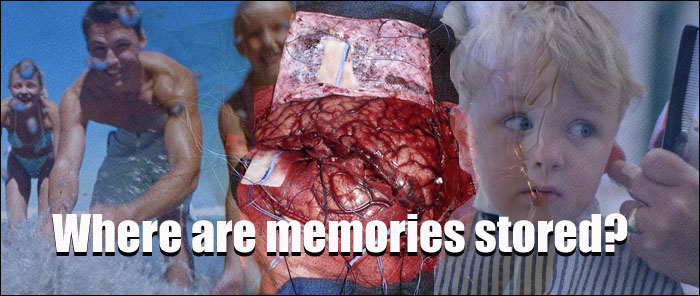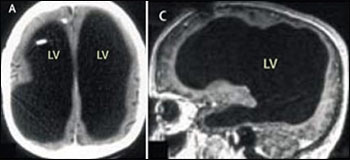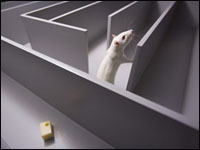
Are your memories really in your brain?
It shouldn't be surprising that computers are designed to work like our own minds. They have basically three different types of memory to store data. There's the Randon Access Memory (RAM), the Hard Drive (HD) and the archival storage like CD's, flash drives and such. While we can point to the components in our computer which store this digital memory, scientists are still unable to explain exactly where memory is stored in our brains.
We assume that our memories are somewhere inside our cranium. The common belief is that they are stored in brain cells which can be stimulated and retrieved. This view of memory storage is supported by neurosurgeons who use electrical stimulation during delicate brain operations. They do these operations with the patient awake and the electrical stimulation is done to determine which areas of the brain control vital functions so they can avoid damaging or accidentally removing them with a tumor. Frequently, patient report that this stimulation triggers detailed memories of past experiences which are replayed like a video in their mind.
Over many decades of medical history, patients have had large chucks of their brains removed -- just about every region -- and many reported only small or insignificant memory loss. One famous 44 year old French patient [right] had completely intact memory despite the discovery that his skull almost completely empty! It was full of fluid with just a few centimeters of brain tissue surrounding this empty space, clinging to the bony cranium. He apparently suffered from encephalopathy as an infant and it was never previously detected.
While we don't know where memories are stored, we do know that certain areas of our brain are responsible for recording, archiving, and retrieving them. When these special parts of the brain are injured, like the hypocampus, certain types of memories are unable to be accessed. But when these brain parts recover their function, the old memories are found intact. So where were they hiding?
In the 1920s the behavioral psychologist Karl Lashley conducted a now famous series of experiments in an attempt to identify the part of the brain in which memories are stored. He trained rats to find their way through a maze, then made lesions in different parts of the cerebral cortex in an attempt to erase what he called the "engram," or the original memory trace. Lashley failed to find the engram -- his experimental animals were still able to find their way through the maze, no matter where he put lesions on their brains. He therefore concluded that memories are not stored in any single area of the brain, but are instead distributed throughout it.
The brain as a receiver
A good friend of mine is a Jainist. This religion and philosophy teaches that the mind is separate from the body and soul. He describes the mind as a kind of radio receiver or television which is receiving a signal. He says that believing that memories are inside the brain is like believing that movie actors are living inside my television. So I asked him, "If this is true, then where is the broadcast coming from?"
Author and researcher, Dr. Rupert Sheldrake has proposed that memory is inherent to all organically formed structures and systems. We can see it in the pattern of a spider's web, hear it in the unique song of a bird and witness it in the way certain salamanders can regrow a lost limb. These instructions are not taught and do not come from inside the organism. While this information is expressed through genes, it does not have its primary origin in them. Instead, his hypothesis states, the organism develops under the influence or memories of previous similar organisms, by a mechanism he has dubbed morphic resonance.
This is beautifully illustrated in the Australian Aboriginals who seem to "unlock" memories of their ancestors through a highly personal experience they call the "walkabout." At certain times in their lives they venture off on their own in the remote "outback" wilderness where they perform various rituals. The experience seems to unlock memories and knowledge that becomes a part of their personal experience, much as if they had studied or memorized it. Some people think all humans have this innate ability but so-called "modern man" has developed tools like language and writing (and yes, computers) as a substitute for these latent abilities.
Three types of memory
Just like the RAM, HD and Archives, humans have three similar types of memory. I hope to demonstrate these to you in this article.
The first type is called "sensory memory." It's equivalent to the Random Access Memory (RAM) in your computer. RAM is only active when there is power. When you turn your computer off it goes blank. Its function is to allow you to perform tasks in the present or "now" and to process the data that you need to be conscious and aware. It doesn't last long, but it is quite powerful and can store many things at once.
When you are driving your car in traffic you use sensory memory. It allows you to keep track of the other cars, adjust your speed, read signs and make the "real time" movements to steer your car. It can absorb an enormous amount of information, mainly visual, and provides continuity to your perception of time.
As we showed in a previous article on viewzone, even our concept of "now" is a memory, usually running milliseconds behind what has already happened.
Sensory Memory explained
George Sperling is a cognitive psychologist who documented the existence of sensory memory. Sperling was able to prove that human beings store a perfect image of the visual world for a brief moment, before it is discarded from memory. In 1960, Sperling performed an experiment using a matrix with three rows of four letters. Participants of the study were asked to look at the letters for one second, then recall them immediately afterwards in any order.
This technique, called "free recall" showed that participants were able to, on average, recall 4-5 letters of the 12 they were given. Sperling believed that all 12 letters were stored in the viewer's memory for a short period of time, but the memory failed so rapidly that only 4 or 5 could be recalled.
Studies have shown that most people cannot remember more than seven numbers when shown a series of many numbers and asked to immediately repeat them. So Sperling's experiment really proved nothing new. Next he tried a slightly different experiment.
The next experiment was similar to the first, however, instead if allowing participants to recall ANY of the letters, he allowed them to view the same matrix for one second, and then hear a pitch (high, medium or low pitch) corresponding to different rows (top, middle or bottom row) in the matrix. The viewer was asked to recall only the letters in that corresponding row. On average, viewers did pretty good on these trials. I'd like you to try this yourself now.
Below is a flash animation that will show you three rows of letters that are colored Green, Red and Blue. You will be sown this matrix for only one second. Immediately following this you will be asked to recite the letters of a specific row which will be indicated by a corresponding colored circle (instead of a tone).
You might want to get a piece of paper to write these down or have someone else record them as you shout them out. You can try it a couple of times as it will show you three sets of letters and loop indefinitely. Good luck.
REQUIRES FLASH PLAYER
How did you do? It's not easy but you probably were able to get some of the letters correct the first time -- and most of them correct on the second or third try.
Now get ready for the second part of the experiment. The animation will appear on the top of the next page. The exact same instructions apply. Good luck.
Comments: |
 But other medical procedures only complicate the understanding of where memories reside in the brain.
But other medical procedures only complicate the understanding of where memories reside in the brain.  Holographic Brain?
Holographic Brain? According to Sheldrake, memory does not reside in any geographic region of the brain, but instead in a kind of field surrounding and permeating the brain. Meanwhile, the brain itself acts as a "decoder" for the flux of information produced by the interaction of each person with their environment.
According to Sheldrake, memory does not reside in any geographic region of the brain, but instead in a kind of field surrounding and permeating the brain. Meanwhile, the brain itself acts as a "decoder" for the flux of information produced by the interaction of each person with their environment.
